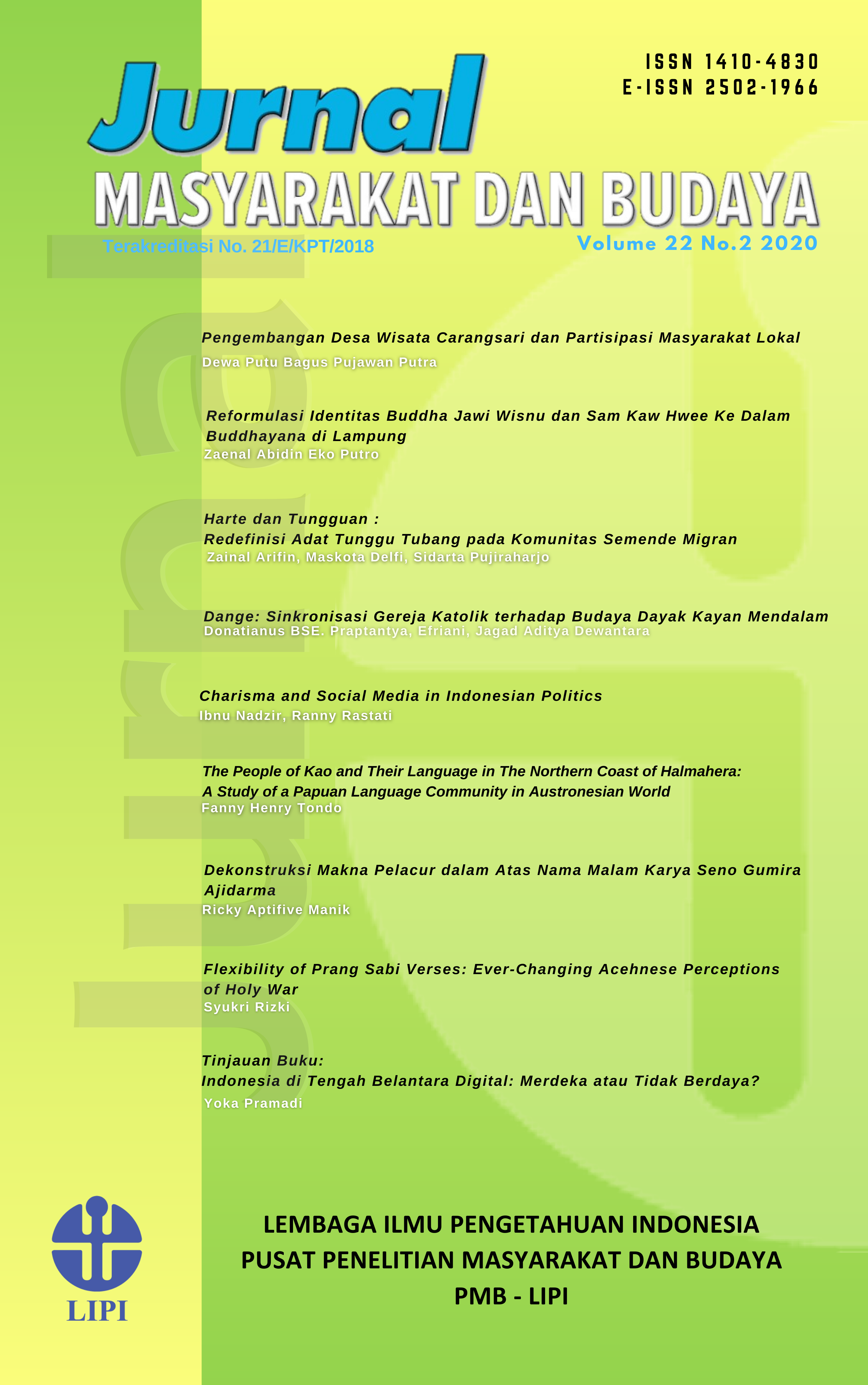HARTE DAN TUNGGUAN : REDEFINISI ADAT TUNGGU TUBANG PADA KOMUNITAS SEMENDE MIGRAN
DOI:
https://doi.org/10.14203/jmb.v22i2.887Keywords:
tunggu tubang, jenang, redefenisi, kekuasaan, penguasaanAbstract
Semende community at Muara Sahung, Bengkulu is ethnic group who migrated from Semende origin (Muara Enim) in South Sumatra Province. Semende community in this Muara Sahung coexist with various communities with a strong patrilineal culture value, where inheritance of property prefer men. In contrast to Semende cultural, with tunggu tubang customary, women (especially the eldest daughter) are important public and preferably as a ruler, and guards who utilize the inheritance his parents. As a cultural identity, tunggu tubang in Muara Sahung community still sustained. But the strong cultural intervention from the communities around it, then going on redefinition of tunggu tubang custom. The process of redefinition is done by the conceptualization of inheritance against itself, so that gave rise to the concept of tungguan (usually in the form of a house), and harte (usually in the form of land). The conceptualization of this custom was eventually also carry consequences where mastery against the tungguan more left to the woman (tunggu tubang), while mastery against harte were handed to men (jenang).
Downloads
References
Alihanafiah. (2008). Mengenal sepintas masyarakat hukum adat Semende. Jakarta: Pemda Tk.I Sumatera Selatan.
Denzin, N. K., dan Lincoln, Y. S. (Eds). (1994). Handbook of qualitative research. Thousand Oaks London-New Delhi: Sage Publications.
Guspitawaty, E. (2002). Penyimpangan sistem pewari-san yang terjadi pada masyarakat hukum adat Semendo Pulau Beringin Kabupaten OKU, Propinsi Sumatera Selatan [Tesis]. Magister Kenoktariatan, Universitas Diponegoro Semarang.
Iskandar. (2003). Kedudukan anak tunggu tubang dalam pewarisan masyarakat adat suku Semendo di Kota Palembang [Tesis]. Magister Kenoktariatan, Universitas Diponegoro Semarang.
Lan, T. J. (2006). Redefinisi etnisitas dalam konteks kebudayaan nasional. Jurnal Masyarakat dan Budaya, 8(1), 123–140.
Mattison, S. M. (2011). Evolutionary contributions to solving the matrilineal puzzle. Human Nature: An Interdisciplinary Biosocial Perspective, 22(1-2), 64–88.
Mellor, K., & Schiff, E. (1975). Redefining. Transac-tional Analysis Bulletin, 5(3), 303–311.
Moyer, D. S. (1984). South Sumatra in the Indonesia field of anthropological study. Dalam de Jos-selin de Jong J. P. B. (Ed.), Unity in diversity, 88–99. Dordrecht-Holland: Foris Publication.
Murdiati, E., Sriati, Alfitri, Muhammad, & Taqwa, R. (2018). The local wisdom of tunggu tubang culture in the challenges of the times (Study on ethnical Semende District Muara Enim South Sumatera). Makalah dipresentasikan dalam The 1st Sriwijaya International Conference on Environmental Issues 2018 (1st SRICOENV 2018), 26–27 September 2018. Palembang: Universitas Sriwijaya.
Naim, M. (1984). Merantau: Pola migrasi suku Minangkabau. Yogyakarta: Gadjah Mada University Press.
Praditama, M. R, Suntoro, I., & Adha, M. M. (2013). Sikap masyarakat terhadap adat tunggu tubang di Desa Pulau Panggung Kecamatan Semende Sarat Laut, Kabupaten Muara Enim. Journal Kultur Demokrasi, 1(5). Bandar Lampung : FKIP Universitas Lampung.
Saputro, A. R., & Wirawan, B. (2013). Persepsi masyarakat Semende terhadap pembagian harta warisan dengan sistem tunggu tubang. Jurnal Sosiologi, 15(1), 51–62.
Setiawan, R. (2013). Status dan peranan tunggu tubang serta perubahannya pada masyarakat Semende Desa Muara Tenang Kecamatan Semende Darat Tengah Kabupaten Muara Enim [Skripsi]. Jurusan Sosiologi, FISIP Universitas Sriwijaya. Palembang.
Setiawan, H., & Darmawan, C. (2016). Pelestarian adat Semende di Desa Ulu Danau, Provinsi Sumatera Selatan. Journal of Urban Society’s Arts, 3(2), 57–63.
Triwurjani, Rr. (2014). Arca perempuan dan arca laki-laki pada kelompok arca megalitik Pasemah, Sumatera Selatan: Perpespektif gender. Jurnal Forum Arkeologi, 27(3), 35–46.

Published
Issue
Section
Copyright (c) 2020 Zainal Arifin

This work is licensed under a Creative Commons Attribution-NonCommercial-NoDerivatives 4.0 International License.
Authors who publish with this journal agree to the following terms:
- The copyright for articles in this journal is retained by the authors.
- Authors grant to the journal first publication rights and the right to distribute the article, including the journal's web site, online data bases and other similar forms.
- Authors agree to license their work according to Creative Commons Attribution-NonCommercial-NoDerivatives 4.0 International License.
- Articles published in JMB are free to use for non-commercial uses as long as the authors and the journal are attributed properly and the new creations are licensed under the indentical terms (license Creative Commons (CC BY-NC-ND 4.0).
- Authors retain the right to reproduce and distribute their articles in any format, without prior authorization, with the proper acknowledgment to the first publication.
- If the article contains copyright material owned by others, authors should obtain written permission from the copyright owner/s in order to reuse the material. Appropriate acknowledgment should be included.
- Authors are encouraged to post their article online (in institutional repositories, personal websites etc). Any such posting must include a reference and a link to the journal's website.
Penulis yang menerbitkan pada jurnal ini menyetujui ketentuan berikut:
- Hak cipta untuk artikel dalam jurnal ini disimpan oleh penulis.
- Penulis memberikan kepada jurnal hak publikasi pertama dan hak untuk mendistribusikan artikel, termasuk situs web jurnal, basis data online dan bentuk serupa lainnya.
- Penulis setuju untuk melisensikan karya mereka sesuai dengan Creative Commons Attribution-NonCommercial-NoDerivatives 4.0 International License.
- Artikel yang diterbitkan dalam JMB bebas digunakan untuk penggunaan non-komersial selama penulis dan jurnal dikaitkan dengan benar dan kreasi baru dilisensikan menurut istilah indentis (lisensi Creative Commons (CC BY-NC-ND 4.0).
- Penulis mempertahankan hak untuk mereproduksi dan mendistribusikan artikel mereka dalam format apa pun, tanpa izin sebelumnya, dengan pengakuan yang tepat untuk publikasi pertama.
- Jika artikel tersebut berisi materi hak cipta yang dimiliki oleh orang lain, penulis harus mendapatkan izin tertulis dari pemilik hak cipta untuk menggunakan kembali materi tersebut. Pengakuan yang tepat harus disertakan.
- Penulis didorong untuk memposting artikel mereka secara online (dalam repositori institusional, situs web pribadi dll). Setiap posting seperti itu harus menyertakan referensi dan tautan ke situs web jurnal.
.png)









